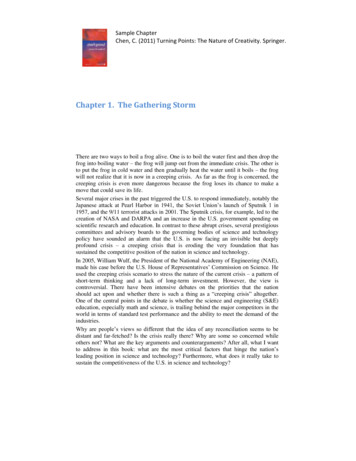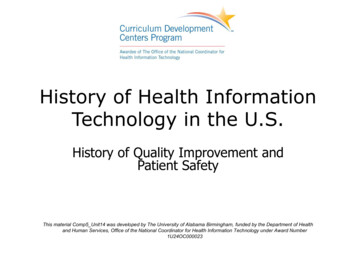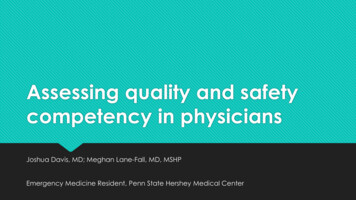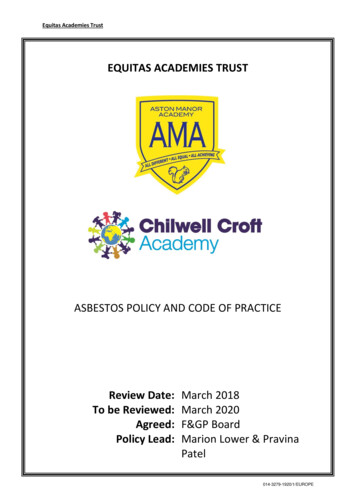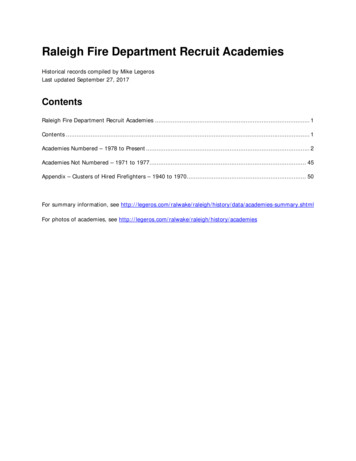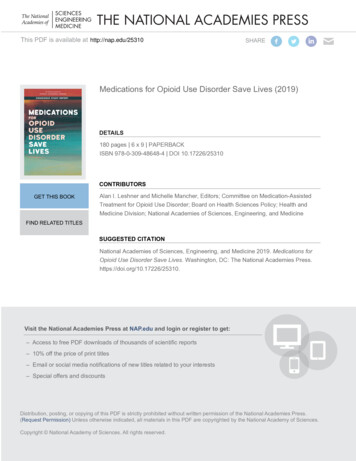
Transcription
THE NATIONAL ACADEMIES PRESSThis PDF is available at http://nap.edu/25310SHARE Medications for Opioid Use Disorder Save Lives (2019)DETAILS180 pages 6 x 9 PAPERBACKISBN 978-0-309-48648-4 DOI 10.17226/25310CONTRIBUTORSGET THIS BOOKAlan I. Leshner and Michelle Mancher, Editors; Committee on Medication-AssistedTreatment for Opioid Use Disorder; Board on Health Sciences Policy; Health andMedicine Division; National Academies of Sciences, Engineering, and MedicineFIND RELATED TITLESSUGGESTED CITATIONNational Academies of Sciences, Engineering, and Medicine 2019. Medications forOpioid Use Disorder Save Lives. Washington, DC: The National Academies Press.https://doi.org/10.17226/25310.Visit the National Academies Press at NAP.edu and login or register to get:– Access to free PDF downloads of thousands of scientific reports– 10% off the price of print titles– Email or social media notifications of new titles related to your interests– Special offers and discounts Distribution, posting, or copying of this PDF is strictly prohibited without written permission of the National Academies Press.(Request Permission) Unless otherwise indicated, all materials in this PDF are copyrighted by the National Academy of Sciences.Copyright National Academy of Sciences. All rights reserved.
Medications for Opioid Use Disorder Save LivesMedications for Opioid Use Disorder SaveLivesCommittee on Medication-Assisted Treatment for Opioid Use DisorderAlan I. Leshner and Michelle Mancher, EditorsBoard on Health Sciences PolicyHealth and Medicine DivisionA Consensus Study Report ofPREPUBLICATION COPY: UNCORRECTED PROOFSCopyright National Academy of Sciences. All rights reserved.
Medications for Opioid Use Disorder Save LivesTHE NATIONAL ACADEMIES PRESS 500 Fifth Street, NW, Washington, DC 20001This activity was supported by a contract between the National Academy of Sciences and theNational Institutes of Health (HHSN263201800029I/HHSN26300005) and the Substance Abuseand Mental Health Services Administration. Any opinions, findings, conclusions, orrecommendations expressed in this publication do not necessarily reflect the views of anyorganization or agency that provided support for the project.International Standard Book Number-13: 978-0-309-XXXXX-XInternational Standard Book Number-10: 0-309-XXXXX-XDigital Object Identifier: https://doi.org/10.17226/25310Library of Congress Control Number:Additional copies of this publication are available from the National Academies Press, 500 FifthStreet, NW, Keck 360, Washington, DC 20001; (800) 624-6242 or (202) 334-3313;http://www.nap.edu.Copyright 2019 by the National Academy of Sciences. All rights reserved.Printed in the United States of AmericaSuggested citation: National Academies of Sciences, Engineering, and Medicine. 2019.Medications for opioid use disorder save lives. Washington, DC: The National Academies Press.doi: https://doi.org/10.17226/25310.PREPUBLICATION COPY: UNCORRECTED PROOFSCopyright National Academy of Sciences. All rights reserved.
Medications for Opioid Use Disorder Save LivesThe National Academy of Sciences was established in 1863 by an Act of Congress, signed byPresident Lincoln, as a private, nongovernmental institution to advise the nation on issuesrelated to science and technology. Members are elected by their peers for outstandingcontributions to research. Dr. Marcia McNutt is president.The National Academy of Engineering was established in 1964 under the charter of theNational Academy of Sciences to bring the practices of engineering to advising the nation.Members are elected by their peers for extraordinary contributions to engineering. Dr. C. D.Mote, Jr., is president.The National Academy of Medicine (formerly the Institute of Medicine) was established in1970 under the charter of the National Academy of Sciences to advise the nation on medicaland health issues. Members are elected by their peers for distinguished contributions tomedicine and health. Dr. Victor J. Dzau is president.The three Academies work together as the National Academies of Sciences, Engineering,and Medicine to provide independent, objective analysis and advice to the nation andconduct other activities to solve complex problems and inform public policy decisions. TheNational Academies also encourage education and research, recognize outstandingcontributions to knowledge, and increase public understanding in matters of science,engineering, and medicine.Learn more about the National Academies of Sciences, Engineering, and Medicine atwww.nationalacademies.org.PREPUBLICATION COPY: UNCORRECTED PROOFSCopyright National Academy of Sciences. All rights reserved.
Medications for Opioid Use Disorder Save LivesConsensus Study Reports published by the National Academies of Sciences, Engineering, andMedicine document the evidence-based consensus on the study’s statement of task by anauthoring committee of experts. Reports typically include findings, conclusions, andrecommendations based on information gathered by the committee and the committee’sdeliberations. Each report has been subjected to a rigorous and independent peer-reviewprocess and it represents the position of the National Academies on the statement of task.Proceedings published by the National Academies of Sciences, Engineering, andMedicine chronicle the presentations and discussions at a workshop, symposium, orother event convened by the National Academies. The statements and opinions contained inproceedings are those of the participants and are not endorsed by other participants, theplanning committee, or the National Academies.For information about other products and activities of the National Academies, pleasevisit ATION COPY: UNCORRECTED PROOFSCopyright National Academy of Sciences. All rights reserved.
Medications for Opioid Use Disorder Save LivesCOMMITTEE ON MEDICATION-ASSISTED TREATMENT FOR OPIOID USEDISORDERALAN I. LESHNER (Chair), Chief Executive Officer Emeritus, American Association for theAdvancement of ScienceHUDA AKIL, Co-Director and Research Professor, Molecular & Behavioral NeuroscienceInstitute; Distinguished University Professor and Quarton Professor of Neurosciences,Department of Psychiatry, University of MichiganCOLLEEN BARRY, Fred & Julie Soper Professor and Chair, Department of Health Policy andManagement, Johns Hopkins Bloomberg School of Public HealthKATHLEEN CARROLL, Albert E. Kent Professor of Psychiatry, Yale School of MedicineCHINAZO CUNNINGHAM, Professor, Albert Einstein College of Medicine, MontefioreMedical CenterWALTER GINTER, Project Director, Medication Assisted Recovery Support ProjectTRACI GREEN, Associate Professor, Emergency Medicine; Associate Director and SeniorScientist, Injury Prevention Research Center, Boston University/Boston Medical CenterYASMIN HURD, Ward Coleman Chair of Translational Neuroscience; Director, AddictionInstitute at Mount Sinai, Icahn School of Medicine at Mount SinaiALAN JETTE, Professor, MGH Institute of Health ProfessionsLAURA R. LANDER, Associate Professor and Addiction Therapist, Department of BehavioralMedicine and Psychiatry and Department of Neuroscience, West Virginia UniversityDAVID PATTERSON SILVER WOLF, Associate Professor, Washington UniversitySEUN ROSS, Director, Nursing Practice and Work Environment, American Nurses AssociationSCOTT STEIGER, Associate Clinical Professor of Medicine and Psychiatry, University ofCalifornia, San FranciscoDAVID VLAHOV, Associate Dean for Research and Professor, Yale University School ofNursingStudy StaffMICHELLE MANCHER, Study DirectorCLARE STROUD, Senior Program OfficerEMILY BUSTA, Associate Program Officer (until September 2018)BENJAMIN KAHN, Associate Program OfficerDANIEL FLYNN, Research Associate (until December 2018)MEREDITH HACKMANN, Research Associate (until December 2018)MICHAEL BERRIOS, Senior Program AssistantMARIAM SHELTON, Board on Health Sciences Policy Program CoordinatorDANIEL BEARSS, Research LibrarianANDREW M. POPE, Director, Board on Health Sciences PolicyConsultantANNA NICHOLSON, Science writerPREPUBLICATION COPY: UNCORRECTED PROOFSvCopyright National Academy of Sciences. All rights reserved.
Medications for Opioid Use Disorder Save LivesCopyright National Academy of Sciences. All rights reserved.
Medications for Opioid Use Disorder Save LivesReviewersThis Consensus Study Report was reviewed in draft form by individuals chosen for theirdiverse perspectives and technical expertise. The purpose of this independent review is toprovide candid and critical comments that will assist the National Academies of Sciences,Engineering, and Medicine in making each published report as sound as possible and to ensurethat it meets the institutional standards for quality, objectivity, evidence, and responsiveness tothe study charge. The review comments and draft manuscript remain confidential to protect theintegrity of the deliberative process.We thank the following individuals for their review of this report:JAN M. BROWN, SpiritWorks Foundation Center for the SoulH. WESTLEY CLARK, Santa Clara UniversityKELLY J. CLARK, American Society of Addiction MedicineBRANDEE IZQUIERDO, SAFE ProjectCHRISTOPHER M. JONES, Centers for Disease Control and PreventionPAULA J. LUM, University of California, San FranciscoSANDRA A. SPRINGER, Yale School of MedicineJOYCELYN SUE WOODS, National Alliance for Medication Assisted RecoveryAlthough the reviewers listed above provided many constructive comments andsuggestions, they were not asked to endorse the conclusions or recommendations of this report,nor did they see the final draft before its release. The review of this report was overseen byJOHN H. KRYSTAL, Yale University School of Medicine, and KRISTINE GEBBIE,Flinders University School of Nursing and Midwifery. They were responsible for making certainthat an independent examination of this report was carried out in accordance with the standardsof the National Academies and that all review comments were carefully considered.Responsibility for the final content rests entirely with the authoring committee and the NationalAcademies.PREPUBLICATION COPY: UNCORRECTED PROOFSviiCopyright National Academy of Sciences. All rights reserved.
Medications for Opioid Use Disorder Save LivesCopyright National Academy of Sciences. All rights reserved.
Medications for Opioid Use Disorder Save LivesPrefaceThe United States is experiencing a public health crisis of almost unprecedented scale:an epidemic of opioid use disorder and related overdose deaths. It is not wholly new, sinceopioid addiction and the resulting societal disruption have been major problems in manycountries for hundreds of years, but its magnitude has increased exponentially in the pastdecades.As this Consensus Study Report articulates, modern medicine and the science thatunderpins it have developed and provided a set of highly effective tools that can help address theopioid epidemic—specifically, three U.S. Food and Drug Administration–approvedmedications—that have been severely underused, even in the health care sector. Theireffectiveness and why they are not more widely used are the subjects of this report. Most of thefactors impeding their full use can and must be dealt with if real progress is to be made. Thesefactors include the misunderstandings and stigma surrounding both addiction and themedications used to treat it as well as counterproductive ideologies that consider addictionsimply a failure of will or a moral weakness, as opposed to understanding opioid use disorder asa chronic disease of the brain that requires medical treatment. This misunderstanding and stigmamust be addressed; they have resulted in hundreds of thousands of patients being denied accessto life-saving medications on non-medical, non-scientific grounds, which our committeeconsiders to be unethical.As with all such studies, the committee developed its conclusions based on a review ofthe scientific literature as it stands at the point in time of the committee’s work. Fortunately,there is a robust research enterprise that is continuing to work on opioid use disorder and itstreatment. We are confident that these efforts will yield results that will continue to increaseunderstanding of opioid use disorder and the most effective ways to prevent and treat it.Knowledge needs include refining in detail the most effective protocols for administeringmedications to specific individuals and subpopulations and the identification of additionalmolecular targets and approaches to enable the development of new and even more effectivemedications. Other research needs are discussed throughout the report.The committee would like to express its great appreciation to the study director, MichelleMancher, and her colleagues on the National Academies staff whose dedication, competence,and hard work have greatly improved the quality of this report. We also greatly appreciate theinsight and support of our sponsors, the National Institute on Drug Abuse of the NationalInstitutes of Health and the Substance Abuse and Mental Health Services Administration.Alan I. Leshner, ChairCommittee on Medication-Assisted Treatment of Opioid Use DisorderPREPUBLICATION COPY: UNCORRECTED PROOFSixCopyright National Academy of Sciences. All rights reserved.
Medications for Opioid Use Disorder Save LivesCopyright National Academy of Sciences. All rights reserved.
Medications for Opioid Use Disorder Save LivesContentsACRONYMS AND ABBREVIATIONSxvSUMMARYS-11 INTRODUCTIONCharge to the Committee and Study Scope, 1-5Conceptual Framework and Key Terms, 1-6Study Methodology, 1-10Organization of the Report, 1-10Conclusion, 1-11References, 1-111-12 THE EFFECTIVENESS OF MEDICATION-BASEDTREATMENT FOR OPIOID USE DISORDER2-1Methadone, 2-2Buprenorphine, 2-3Extended-Release Naltrexone, 2-4Naloxone, 2-5Evidence on the Effectiveness of FDA-Approved Medications in Treating OUD, 2-5Knowledge Gaps and Future Directions for Research on Medications for OUD, 2-8Behavioral Therapy in Conjunction with Medications, 2-12Knowledge Gaps and Additional Research Needed on the Role of Behavioral Interventionswith Medications in Treatment for OUD, 2-14Conclusions, 2-15References, 2-163 TREATMENT WITH MEDICATIONS FOR OPIOID USE DISORDERIN DIFFERENT POPULATIONSMedication-Based Treatment for OUD Across the Life Course, 3-2Sex-Related Differences in Medication-Based Treatment for OUD, 3-4Pregnant Women, 3-5Sexual Minorities, 3-6Individuals with Other Comorbidities, 3-7Racial and Ethnic Minority Populations, 3-10Low Socioeconomic Status Populations, 3-12Rural and Urban Populations, 3-12Conclusion, 3-13References, 3-134MEDICATIONS FOR OPIOID USE DISORDERBY TREATMENT SETTINGOpioid Treatment Programs, 4-3Office-Based Opioid Treatment, 4-4Acute Care Settings, 4-6Other Care Settings, 4-6PREPUBLICATION COPY: UNCORRECTED PROOFSxiCopyright National Academy of Sciences. All rights reserved.3-14-1
Medications for Opioid Use Disorder Save LivesCriminal Justice Settings, 4-7Innovative Settings for OUD Treatment, 4-9Conclusion, 4-10References, 4-105 BARRIERS TO BROADER USE OF MEDICATIONSTO TREAT OPIOID USE DISORDERStigma, 5-2Inadequate Professional Education and Training, 5-5System Fragmentation, 5-6Legal and Regulatory Barriers, 5-7Public and Private Insurance Barriers, 5-11Conclusion, 5-14References, 5-14APPENDIXESA Study Approach and MethodsB Public Workshop AgendaC Biographical Sketches of Committee MembersPREPUBLICATION COPY: UNCORRECTED PROOFSxiiCopyright National Academy of Sciences. All rights reserved.5-1A-1B-1C-1
Medications for Opioid Use Disorder Save LivesBoxes and FiguresBOXESS-1S-2S-3Medication-Based Treatment for Opioid Use Disorder, S-2Summary of Conclusions, S-2Statement of Task, S-81-11-21-31-41-5Medication-Based Treatment for Opioid Use Disorder, 1-3U.S. Food and Drug Administration–Approved Medications for the Treatment of OpioidUse Disorder, 1-3Statement of Task, 1-5Diagnostic Criteria for Opioid Use Disorder, 1-7Key Terms, 1-82-12-2FDA-Approved Medications for the Treatment of Opioid Use Disorder, 2-2Types of Behavioral Interventions, 2-123-1National Estimates of People with Opioid Use Disorder (OUD) Receiving MedicationBased Treatment, 3-14-1Office-Based Methadone Treatment, 4-4FIGURES4-14-24-3All substance use disorder facilities, by county (2018), 4-2Substance use disorder facilities offering medications for OUD, by county (2018), 4-2Substance use disorder treatment facilities offering all three medications for OUD,by county (2018), 4-3PREPUBLICATION COPY: UNCORRECTED PROOFSxiiiCopyright National Academy of Sciences. All rights reserved.
Medications for Opioid Use Disorder Save LivesCopyright National Academy of Sciences. All rights reserved.
Medications for Opioid Use Disorder Save LivesAcronyms and AbbreviationsAAPACAAmerican Academy of PediatricsPatient Protection and Affordable Care ActCARACFRCHCComprehensive Addiction and Recovery ActCode of Federal Regulationscommunity health centerDATADEADrug Addiction Treatment ActDrug Enforcement AdministrationEHRelectronic health recordFDAU.S. Food and Drug AdministrationHCVHIVhepatitis C virushuman immunodeficiency virusMATMHPAmedication-assisted treatmentMental Health Parity ActNPNSDUHnurse practitionerNational Survey on Drug Use and HealthOTPOUDopioid treatment programopioid use disorderPAphysician assistantQTccorrected QT intervalSAMHSAsiOATSROMSUDSubstance Abuse and Mental Health Services Administrationsupervised injectable opioid agonist treatmentslow-release oral morphinesubstance use disorderTHCtetrahydrocannabinolPREPUBLICATION COPY: UNCORRECTED PROOFSxvCopyright National Academy of Sciences. All rights reserved.
Medications for Opioid Use Disorder Save LivesCopyright National Academy of Sciences. All rights reserved.
Medications for Opioid Use Disorder Save LivesSummary1The opioid crisis in the United States has come about because of excessive use of thesedrugs for both legal and illicit purposes and unprecedented levels of consequent opioid usedisorder (OUD). More than 2 million people in the United States are estimated to have OUD,which is caused by prolonged use of prescription opioids, heroin, or other illicit opioids. OUD isa life-threatening condition associated with a 20-fold greater risk of early death due to overdose,infectious diseases, trauma, and suicide. Mortality related to OUD continues to escalate as thispublic health crisis gathers momentum across the country, with opioid overdoses killing morethan 47,000 people in 2017 in the United States. Efforts to date have made no real headway instemming this crisis, in large part because tools that already exist—like evidence-basedmedications—are not being deployed to maximum impact. To support the dissemination ofaccurate, patient-focused information about evidence-based treatment for OUD, the NationalInstitute on Drug Abuse and the Substance Abuse and Mental Health Services Administrationasked a committee convened by the National Academies of Sciences, Engineering, and Medicineto examine the evidence base for medications to treat OUD and to identify barriers that preventpeople from accessing safe, effective, medication-based treatment (see Box S-1). The fullStatement of Task to the committee is provided in Box S-3 at the end of this summary.OUD is a chronic brain disease that comes about because of the effects of prolongedopioid use on brain structure and function. These brain changes—and the resulting addiction—can be treated with life-saving medications, but those medications are not available to most ofthe people who need them. Methadone, buprenorphine, and extended-release naltrexone are safeand highly effective medications that are already approved by the U.S. Food and DrugAdministration (FDA) to treat OUD. By alleviating withdrawal symptoms, reducing opioidcravings, or decreasing the response to future drug use, these medications2 make people withOUD less likely to return to drug use and risk a fatal overdose. These medications also helppeople restore their functionality, improve their quality of life, and reintegrate into their familiesand communities. These medications save lives, but the majority of people with OUD in theUnited States receive no treatment at all.1This summary does not include references. Citations for the discussion presented in this summary appear insubsequent report chapters.2Only methadone and buprenorphine alleviate withdrawal symptoms; all three medications decrease craving andblock the euphoric effects of taking other opioids.PREPUBLICATION COPY: UNCORRECTED PROOFSS-1Copyright National Academy of Sciences. All rights reserved.
Medications for Opioid Use Disorder Save LivesS-2MEDICATIONS FOR OUD SAVE LIVESBOX S-1Medication-Based Treatment for Opioid Use DisorderAlthough medication-assisted treatment (MAT) is a term commonly used todescribe treatment programs for opioid use disorder (OUD) that include any of the threeopioid agonist or antagonist medications, the committee chose to use the term“medication-based treatment for OUD” rather than MAT throughout this report. Thischange in nomenclature aligns with the committee’s conceptual framework of OUD as achronic disorder for which medications are first-line treatments that are often an integralpart of a person’s long-term treatment plan, rather than complementary or temporaryaids on the path to recovery.As with any other disease, medications should not be withheld from people with OUDwithout sufficient medical justification. Withholding them on ideological or other non-evidencebased grounds is denying people needed medical care. However, some addiction treatmentfacilities that ban medications are still being supported by funding streams that are tied to thecriminal justice system or housing authorities, creating strong incentives to steer patients towardnon-medication-based treatment approaches.As the number of people with OUD surges, the need for treatment is far outstripping thecurrent capacity to deliver it. A host of systemic barriers prevent people from accessing thosemedications. For example, when OUD treatment delivery settings are separate from the rest ofmedical care, the surrounding regulatory and legal requirements can impose hard-to-overcomebarriers on accessing medication-based treatment for OUD. The current system of care deliveryfor OUD is fragmented and inequitable, so that a coordinated response will be required toovercome the inertia that has allowed the crisis to spiral to this extent. Box S-2 summarizes themajor conclusions of the report. Curbing the epidemic will require an “all hands on deck”strategy across every sector—health care, criminal justice, patients and their family members,and beyond—because no sector alone will be able to resolve the crisis. Making access tomedications much broader and more equitable is a high priority for making meaningful progressin saving lives of those with OUD.BOX S-2Summary of Conclusions1. Opioid use disorder is a treatable chronic brain disease.2. U.S. Food and Drug Administration (FDA)-approved medications to treat opioiduse disorder are effective and save lives.3. Long-term retention on medications to treat opioid use disorder is associated withimproved outcomes.4. A lack of availability of behavioral interventions is not a sufficient justification towithhold medications to treat opioid use disorder.5. Most people who could benefit from medication-based treatment for opioid usePREPUBLICATION COPY: UNCORRECTED PROOFSCopyright National Academy of Sciences. All rights reserved.
Medications for Opioid Use Disorder Save LivesSUMMARYS-3disorder do not receive it, and access is inequitable across subgroups of thepopulation.6. Medication-based treatment is effective across all treatment settings studied todate. Withholding or failing to have available all classes of FDA-approvedmedication for the treatment of opioid use disorder in any care or criminal justicesetting is denying appropriate medical treatment.7. Confronting the major barriers to the use of medications to treat opioid usedisorder is critical to addressing the opioid crisis.OPIOID USE DISORDER IS A TREATABLE CHRONIC BRAIN DISEASEAddiction is a chronic disease that involves compulsive or uncontrolled use of one ormore substances in the face of negative consequences. As with other chronic medical conditions,a confluence of genetic, environmental, and social factors shape a person’s vulnerability toaddiction and ease of recovery from it. These factors determine a person’s propensity to startusing drugs and to keep using them, as well as a person’s susceptibility to the particular types ofneurobiologic changes in the brain that characterize the progression to addiction. Building ondecades of research, the scientific community has coalesced around the brain disease model ofaddiction. In people with OUD and other substance use disorders, prolonged and repeated druguse over time cause lasting effects on brain structure and function. Prescription and illicit opioidsproduce powerful and sustained effects on the brain’s opioid system; repeated use can disrupt theregulation of the system and result in tolerance, physical dependence, and addiction. Theevidence shows that these brain changes can be treated effectively with medications that helppeople refrain from using drugs, thus sharply reducing their risks of overdose and death. Byalleviating opioid cravings and withdrawal symptoms, the medications can also provideopportunities to address the behavioral and social components of addiction, which are criticallyimportant both to the disorder’s development and treatment.This scientific understanding of OUD is at odds with the prevailing public perception ofthe disorder, which is colored by the misconception of addiction as simply a moral failing. Thatpopular view has proliferated through generations of social stigmatization directed at people whouse drugs; this misinformed stigma has also spread to the medications used to treat OUD. In fact,people with OUD have a chronic disease that, like many others, warrants long-term medicalmanagement beyond episodic acute care incidents.PREPUBLICATION COPY: UNCORRECTED PROOFSCopyright National Academy of Sciences. All rights reserved.
Medications for Opioid Use Disorder Save LivesS-4MEDICATIONS FOR OUD SAVE LIVESMEDICATIONS FOR OPIOID USE DISORDER SAVE LIVESOUD is caused by changes in brain circuitry that can be treated with medication torestore healthy brain function, which leads to improvements in behaviors associated withaddiction. The medications currently approved by FDA for treating OUD are evidence-based,safe, and highly effective. Medication-based treatment for OUD focuses first on managingwithdrawal symptoms and then on controlling or eliminating the patient’s compulsive opioid use,most commonly with the agonist medications methadone or buprenorphine. Large systematicreviews and randomized controlled trials show that patients with OUD who receive thesemedications are less likely to die from overdose or other causes related to their addiction.Patients who receive medication have higher treatment retention rates, better long-term treatmentoutcomes, and improved social functioning; they are also less likely to inject drugs or transmitinfectious diseases. For patients who have gone through withdrawal from opioids for a sufficienttime, extended-release naltrexone may be used for maintenance treatment. Available evidenceclearly supports the use of medications and the need to expand access to medications to reduce oreliminate compulsive opioid use, to reduce the risk of premature death, and to improve thequality of life of people with OUD and their families.Methadone, buprenorphine, and extended-release naltrexone all work by targeting themu-opioid receptor within the opioid system. Because each medication has a distinct mechanismof action, the most appropriate medication and dosage varies across patients and may vary in thesame patient over the course of treatment. The existing medications are very effective, but theyare not perfect; for example, evidence gaps remain about how to choose the most effectivemedication for a particular patient and how best to retain people in treatment, which is itself asignificant problem. Moreover, because OUD has complex behavioral and social causes andconsequences, it is not yet known which behavioral interventions might be most appropriate tohelp restore patients to full functionality. Therefore, even though there is a need to act urgently toimprove access to existing medications, at the same time innovation cannot stagnate. Researchshould continue to focus on developing new and better medications to treat OUD, ondetermining the most effective behavioral therapies to maximize outcomes, and on refining themost appropriate protocols for their effective use.PREPUBLICATION COPY: UNCORRECTED PROOFSCopyright National Academy of Sciences. All rights reserved.
Medications for Opioid Use Disorder Save LivesSUMMARYS-5Evidence demonstrates that patients who receive longer-term treatment with medicationfor OUD have better treatment outcomes; they are also less likely to die from overdose if theyreturn to use while on medication. In fact, people with OUD are up to 50 percent less likely todie when they are being treated long term with methadone or buprenorphine. Further research isneeded to define an optimal treatment regimen for each of the available medications and todirectly compare the effects of the three medications’ long-term use. Nonetheless, in spite of theneed for more research, the body of evidence amassed over the last 50 years underscores thebenefits of long-term retention on medication.Treatment with a combination of medication and evidence-based behavioral interventions(e.g., contingency management approaches, cognitive behavioral therapy, and structured familytherapy) can be eff
LAURA R. LANDER, Associate Professor and Addiction Therapist, Department of Behavioral . Associate Dean for Research and Professor, Yale University School of Nursing Study Staff MICHELLE MANCHER, Study Director CLARE STROUD, Senior Program Officer EMILY BUSTA, Associate Program Officer (until September 2018) BENJAMIN KAHN, Associate Program .



